 |
||
|
||
| ||
A few words about a computer acoustic systemToday many users encounter a problem of choosing a high-quality and not expensive acoustic system for their computers. It is no secret that a more improved, perfect acoustic system will completely change your perception of sound. Some of you might get used to small plastic sound imitators. And if you give such computer speakers to a user who get used to Hi-Fi equipment, it will be a real torture for him. However, the problem is not easy to solve! With a release of 5.1 sound cards we can choose: either to connect a sound card to an external receiver in digital mode, or to use Dolby Digital 5.1 program decoding with algorithms of a soft DVD player and to buy an acoustic system of higher quality for the money saved. The latter variant allows to use 3D technologies in games without much complexity and losses in quality, whether it is a 4-channel sound card with DS3D, EAX and A3D or a 5-channel one with DS3D, EAX, Sensaura and QSound. The today's article deals with exactly such solution - an active 5.1 acoustic system F&D IHOO 5.1. Why can this system be considered as a computer audio solution? First of all, due to its low price. Secondly, many users have no possibility to arrange a home theater in a separate room. Besides, it is not a good idea to wind everything with cables placing a computer and non-computer 5.1 acoustic system. General dataA huge packing box weighs 25 kg. In the box you can find 5 separate acoustic systems and a subwoofer with an integrated power supply unit and an amplifying unit. We have received a complete set of black color, however the system can be decorated under light kinds of wood. 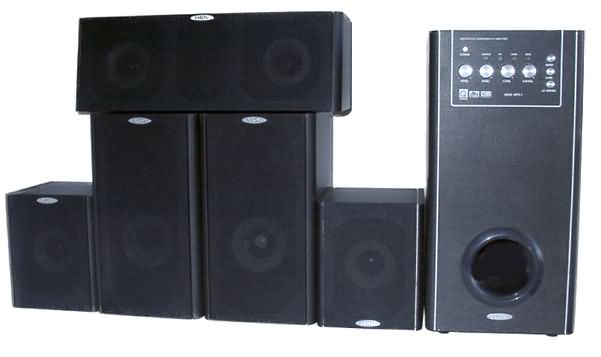 Specification:
Now let us to consider each system separately. Amplifying unitOn the front panel there are separate volume controls for front speakers (F.VOL), rear speakers (S.VOL), for a center (C.VOL) and a subwoofer (S.W.VOL). The BAND button is intended for a successive commutation of signal's stereo sources. 5.1/ST. turns on/off of sound processing by the QSound Multi-Speaker System. AC-3/SURR. switches a signal amplifying mode for the unit from 5.1 analog inputs. "DTS 5.1 ready" and "AC-3 ready" notify that you can connect an external DD5.1/DTS decoder to this amplifier (it can be a computer with a 5.1 sound card, though there are still no soft players which can decode a DTS track). 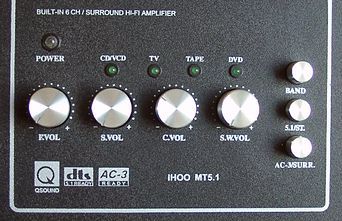 On the rear panel there are outputs to front (F.L/F.R), rear speakers (S.L./S.R.) and a central one (CENTER). The cables can be changed without much difficulty, though a multi-conductor copper cable 1 mm in diameter, shielded with flexible transparent material will hardly need to be replaced. 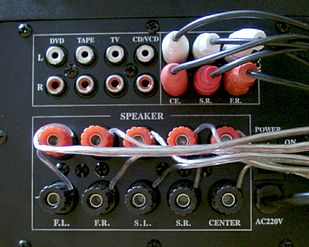 Input connectors are implemented in RCA form. Next to 5.1 analog inputs there are 4 stereo inputs marked as DVD, TAPE, TV and CD/VCD (according to the commutation on the front panel). An amplifier for 5 acoustic channels is based on amplifying chips of class AB TDA 2030A. An amplifying bridge circuit for a subwoofer is based on two LM 1875 chips. At the expense of power amplifying chips mounted on a big black metal heat sink inside the case (all heat sinks are screwed through thermo paste) the developers have managed to provide impermeability for the subwoofer, what a lot of expensive computer solutions are lacking for. 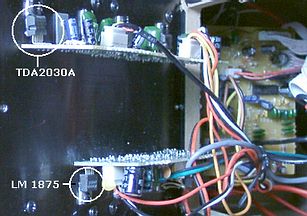 Apart from it the acoustic system includes an interesting analog effect-processor QS7785PF from QSound. The processor is based on the QSound Multi-Speaker System technology in order to synthesize 5 channels from a normal analog stereo signal, thus expanding sound space on a multi-channel 5.1 system. Acoustic systemsThe speakers look impressive without decorative nets. 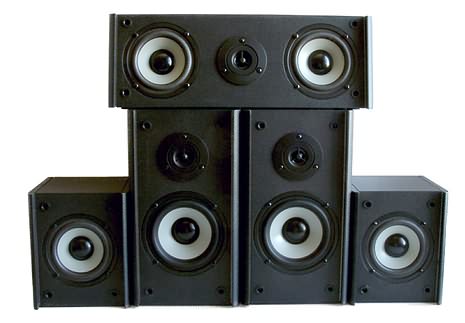 The cases are made of pressed fiberboard 1.5 cm wide. In the speakers there are dynamic heads from F&D. A distinguishing feature of the diffusers is a quite rigid paper and a small travel of the system. This causes not very high sensitivity in view of Hi-Fi equipment. All speakers (including front and central) have a phase-invertor hole on the rear panel. The rear satellites can be hung on a wall since there is a bracket for it. 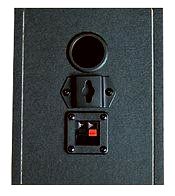 Since the front speakers and a center have small grooved rubber legs, the center stands rigidly on a monitor, and the speakers do not move along the table if music is load. SubwooferAs I have already mentioned above, the subwoofer has an impermeable construction with a phase-invertor's tube of a circular section. A dynamic head is installed on an internal vertical panel which divides a case into two parts. The rigidity is also provided by angles inside the case. This helps to avoid an unpleasant resonance even at the maximum volume level. The subwoofer stands stable on 4 legs made of rubber-plastic. When it stands on the floor all regulators are easy to reach. A location of the power switch on the rear panel makes the only inconvenience in handling. ConnectionTest system configuration:
To use all possibilities of the IHOO 5.1 system you should connect it to a computer either via a 5.1 sound card or via an external DD/DTS decoder with 6 analog outputs. We have tried the both ways. Note that an integrated analog effect-processor 2->5.1 with the QSound technology works only if stereo sources are connected. Hearing testsFortunately, there is no any cracking noise caused by an alternating current what is typical for many computer systems with poor power supply filters. A disc with "Prescription for the Blues" with pianist Horace Silver and saxophonist Michael Brecker was chosen as a test composition. The sound of the jazz composition was quite decent, at the level of not very expensive Hi-Fi equipment. And even not very accurate reproduction within the high middle range was not noticeable. At a small level of Concert Hall reverberation on the Live! Player 5.1 and distribution of the sound among all speakers at a small volume level the music sounded three-dimensional. With an experience of one and a half year of using the SBLive! sound card I have noticed that small and quality reverberation can improve your impression on the sound. Compare how unbearable a violin sounds in a small room and how divine it sounds in a concert hall. But you should carefully make presettings for a reproducing system. Unfortunately, for the Live! only Generic and Concert Hall modes are suitable for listening at a small reverberation level. Due to a rigid sound of the system a violin from the Corrs "in blue" album played a bit suppressed. But the vocalist managed to outperform all imperfections of the audio track and sang beautifully. The subwoofer was quite good here: soft basses expanded the front speakers rich in low frequencies. You will never have a headache with a such subwoofer. When applying a sound to linear stereo inputs and pressing the 5.1 buttons which enable QSound Multi-Speaker System 2->5.1 algorithm, the music sounds interesting and three-dimensional. I think that 90% of users will be satisfied how the IHOO 5.1 system sounds on a CD-DA material. DVDTo check whether the system is really "DTS ready" we used an external DD5.1/DTS decoder Jass Speakers DE-005. The tests on a DVD movie Gladiator showed that the system can play a track in DTS format preliminary decoded with an external decoder! :) It means that it is ready to be equipped with an external DTS unit, as well as the DD5.1. Different DVD trailers with rich audio effects sounded quite good. And a separate volume control of channels allowed to reach very quickly an optimal sound media taking into consideration the time of the day. Comparing with an entry-level home theater which costs 10 times more, the only downside I noticed is some rigidity and flatness of the sound. But as for computer versions of home theater acoustic system, there are only VideoLogic DigiTheatre and DigiTheatre DTS that can compete against our system. This system deserves an excellent mark as a computer home theater set taking into account its price. GamesWhat about games? Does it make sense to buy the active 5.1 acoustic system without an integrated decoder? Yes, it does. For example, in the popular Live! 5.1 card sound sources are spread among 5 separate channels due to DS3D drivers. In the Soldier of Fortune game dialogs come from the central channel with other sounds coming from other channels according to the battle situation. At the Game Developers Conference Creative has concluded an agreement with Dolby on licensing the Dolby Digital 5.1 technologies for a game industry, and, as a result of it, the developers will receive a new interface - Dolby Digital API. The New World Computing was first to announce about using it in their solutions; they are going to introduce a 5.1 sound track as a musical decoration for their "Heroes of Might and Magic". As you know, in the third part and in many mission packs they used mp3 files of 44.1 KHz/128 Kbps, what was quite good at that moment but now it is outdated. Standard listening to 3D shooters UT and Q3 showed nothing to complain about. Despite so terrible samples, explosions and sound atmosphere have made very pleasent impression. At the height of firing the subwoofer worked without problems. In games where developers pay due attention to the sound (HM&M3, Diablo2 etc.) the IHOO 5.1 performed flawlessly as well. SummaryThe active 5.1 acoustic system F&D IHOO 5.1 can be placed on one level with entry-level Hi-Fi systems and is worth paying attention to when choosing a good audio system for a PC with a 5.1 sound card. Highs:
Lows:
Write a comment below. No registration needed!
|
Platform · Video · Multimedia · Mobile · Other || About us & Privacy policy · Twitter · Facebook Copyright © Byrds Research & Publishing, Ltd., 1997–2011. All rights reserved. |